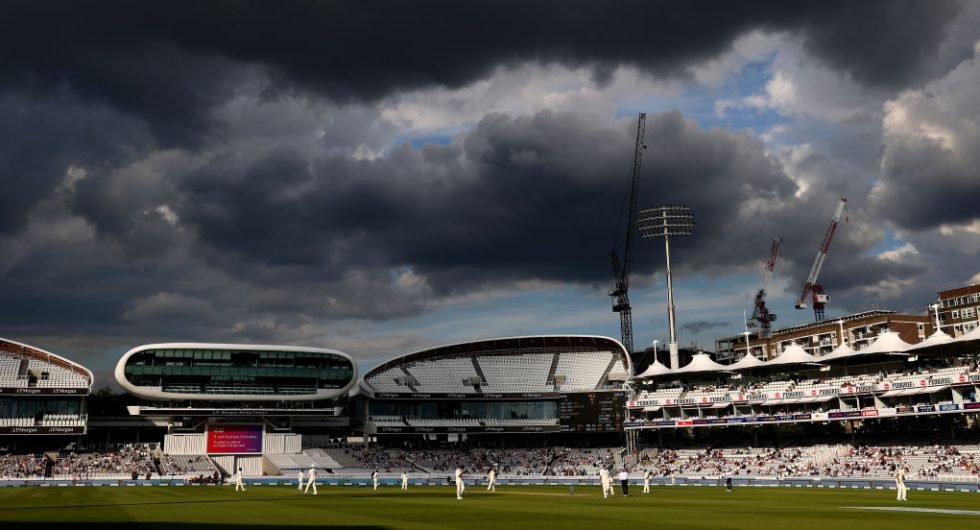When Test cricket’s return to Lord’s was overshadowed by crisis – Almanack

Andy Bull’s report for the Wisden Cricketer’s Almanack on the England v New Zealand 2021 Lord’s Test, a game that featured prominently on the news, but not because of the result.
This should have been one of the summer’s great events. It wasn’t just the first Test, but the first at Lord’s for nearly two years, and the first in front of a crowd anywhere in England for almost as long. After 15 gruelling months of on-off lockdown, the opening morning felt bright with sunshine and promise. Despite the face masks, one-way systems and social-distancing rules which limited daily attendance to around 6,500, Lord’s provided familiar comforts. The place thrummed with delight, and even the oldest members seemed giddy with excitement. It did not last the week.
By stumps on Sunday, the end of the game came almost as a relief, not simply because it washed up in a stultifying draw, but because the match had been overshadowed by a crisis caused by a series of abusive tweets posted in 2012 and 2013 by one of England’s debutants, Ollie Robinson. On the fifth evening, the ECB announced they were suspending him from international cricket pending an investigation, but the incident became a flashpoint in a broader culture war. Next morning, Oliver Dowden, secretary of state for digital, culture, media, and sport, described the ECB’s decision as “over the top”; he was soon supported by the prime minister, Boris Johnson.
The tweets had come to light midway through the first day, when Robinson had embarked on one of the more successful, and controversial, debuts in recent history. Without a group of players who had not long returned from the postponed IPL, England had picked Robinson, whose performances for Sussex over the previous four seasons had made him one of county cricket’s leading bowlers, and Gloucestershire’s James Bracey, handed the gloves after Ben Foakes tore a hamstring slipping in the Oval dressing-room.
They also chose one of the youngest batting line-ups in their history, alongside one of their older bowling attacks. Robinson, at 27, was the junior member, but outbowled Anderson and Broad. He dismissed Latham, playing on, in his first spell, and Taylor, leg-before, in his second. By then his tweets, written in his late teens, were circulating on social media, apparently dug up by a journalism student after a hint dropped by an Australian blogger. The ECB should have been so diligent.
Hours earlier, Robinson and his teammates had lined up in front of the Pavilion before play for what was described as “a moment of unity”. They wore black T-shirts with “Cricket is a Game for Everyone” on the front, and “We Stand Together Against” every conceivable variety of discrimination on the back: racism, religious intolerance, sexism, transphobia, homophobia, ableism, ageism. It was well meant, part of a campaign to make amends for old offences, and to open the sport up to new audiences, but it all looked facile now. Robinson had no idea about the unfolding scandal until the close, which meant many spectators knew more about the story than he did, and had the uncomfortable experience of watching him revel in his first day of Test cricket.
England’s head coach, Chris Silverwood, and captain, Root, told Robinson as soon as play was over. By Silverwood’s account, Robinson immediately gave a full and sincere apology to his teammates, which he expanded on during a TV interview and press conference. He spoke of his regret and shame. He explained how immature he had been when he made the remarks, but didn’t try to excuse them. He had his say. Now everyone else had theirs, in print, and on radio, TV and Twitter. Those on either side of a social, political and cultural divide used the story for their own ends. Some said they would give up on cricket if Robinson were allowed to play again; others insisted they would do the same if he faced any sort of punishment.
Out in the middle, New Zealand were trying to win a Test. They had picked a debutant of their own, Devon Conway, who had a different kind of past. Now 29, he had been born and raised in South Africa, and made his first-class debut for Gauteng in 2008-09. Good judges thought him one of the country’s brightest prospects. Ray White, former president of the South African board, said: “If he is not a future star of international cricket, something will have gone seriously wrong.” White was right, in the end, if perhaps not as he envisaged. For the next eight years, Conway knocked around the outskirts of the professional game – franchise and provincial cricket in South Africa, league and county Second XI cricket in England. It was only after he sold his house and car, and moved to New Zealand in 2017, that he made good on his promise.
Now, he batted with quiet competence and unobtrusive authority, the equal of everything England tried, including a ferocious spell from Wood, who hit him twice. A left-hander Conway raised his fifty with a drive through extra cover off Broad, and his century with a whip over square leg off Robinson. Nicholls was a steady second fiddle. At stumps, Conway had more runs (136) on his first day of Test cricket than anyone since 1983/84, when Australia’s Wayne Phillips smacked 159 against Pakistan at Perth.
Wood and Robinson dovetailed well on the second morning: from 288-3, they collected 4-6 in 52 balls. If anything, Robinson bowled even better than the previous day; he would have had a fifth wicket, and a place on the honours board, had Broad caught Southee at mid-off. The crowd applauded before each spell, and after each wicket. Even that show of support made some uncomfortable: earlier in the week, the England football team had been booed for taking a knee before a friendly against Austria.
Conway pressed on. He had already ticked off the highest score by a Test debutant at Lord’s (beating Sourav Ganguly’s 131 for India in 1996). Now he went past KS Ranjitsinhji’s unbeaten 154, against Australia at Manchester in 1896, to record the highest by a debutant in England. New Zealand’s last man, Wagner, was in when he reached 200 by pulling Wood for his only six. Next over, he was run out by the barest of margins, having dominated a total of 378. After waiting so long for his opportunity, Conway had batted as though he knew how precious it was, for 578 minutes in all. (Only Sri Lanka’s Brendon Kuruppu had managed longer on Test debut: 777 minutes against New Zealand in Colombo in 1986/87.)
His attitude felt all the more conspicuous when England batted, and Crawley became the first to give away his wicket, aiming a loose drive at Southee. As Root said later, the innings included “a number of dismissals that weren’t good enough for Test cricket”. The demise of Lawrence, who fiddled Southee to third slip, was another.
Those mishaps came either side of a Friday washout, which made the match a race against time. On Saturday, England resumed on 111-2, but Root fell first ball that morning, to Jamieson, and the game lurched forward again. Southee bowled artfully from the Pavilion End, and took three wickets in successive overs as 140-3 became 140-6. When Bracey was clean bowled by one that came back up the slope, England were 39 short of avoiding the follow-on. But Burns and Robinson rallied in a 63-run partnership. Burns was dogged: his second fifty took 177 balls, though he raced through the nineties in just seven, because he was running out of partners. His third Test century in the bag, he walloped another 32 from his final 30, including his first six in Tests, a slog-sweep off an incredulous Wagner, and was last out after a tenth-wicket stand of 52 with Anderson. Southee finished with six for 43, his best Test figures since 2012 – and New Zealand’s best at Lord’s, beating his own 6-50 in 2013. They led by 103.
England bowled well in the third innings, and Robinson – putting his off-field troubles to one side – especially so during a spell of 9-4-8-2 on the fourth evening. But New Zealand were in control. Next morning, which included Broad’s first Test wicket in 488 balls, rain meant a slightly early lunch, and Williamson declared, setting 273 in 75 overs.
It was bold captaincy, but England had other ideas. To the despair of their more romantic supporters, they chose to bat out the day, just to show they could. Sibley made a particularly gritty 60 from 207 balls. There had been plenty of times when many would have been delighted to see him play that way. This wasn’t one of them, and there were ironic cheers when the England fifty came up in the 27th over. Crawley fell cheaply again, and New Zealand pressed on long into the last hour, as Wagner tried to flog life into a game everyone else thought dead. Cricket featured prominently on the evening news, but not because of the result. For the English, a match that started with such sweet promise left a rather sour taste.
ENGLAND v NEW ZEALAND, FIRST TEST MATCH
At Lord’s, June 2–6, 2021. Drawn.
Debuts: JR Bracey, OE Robinson, DP Conway
New Zealand 378 (122.4 overs) (DP Conway 200, HM Nicholls 61; OE Robinson 4-75, MA Wood 3-81) and 169-6 dec (52.3 overs) (TWM Latham 36, LRPL Taylor 33; OE Robinson 3-26); England 275 (101.1 overs) (RJ Burns 132, JE Root 42, OE Robinson 42; TG Southee 6-43, KA Jamieson 3-85) and 170-3 (70 overs) (DP Sibley 60*, JE Root 40). Player of the Match: DP Conway.
The 2022 edition of the Wisden Almanack is available to buy here.


